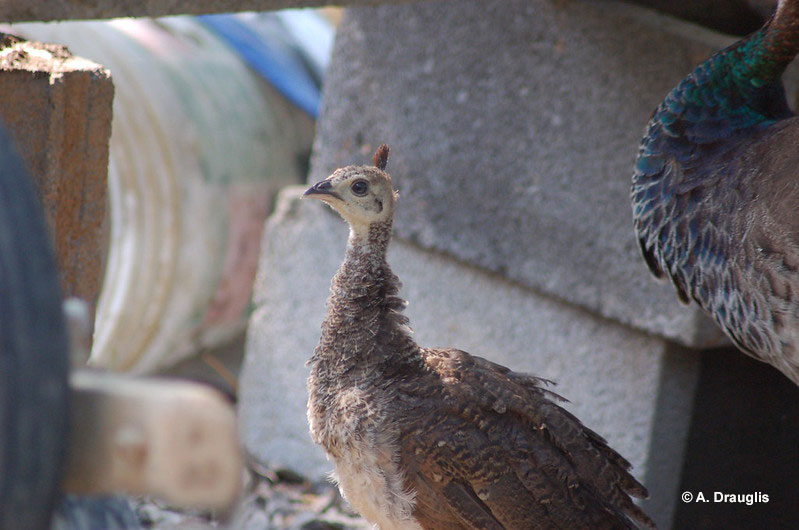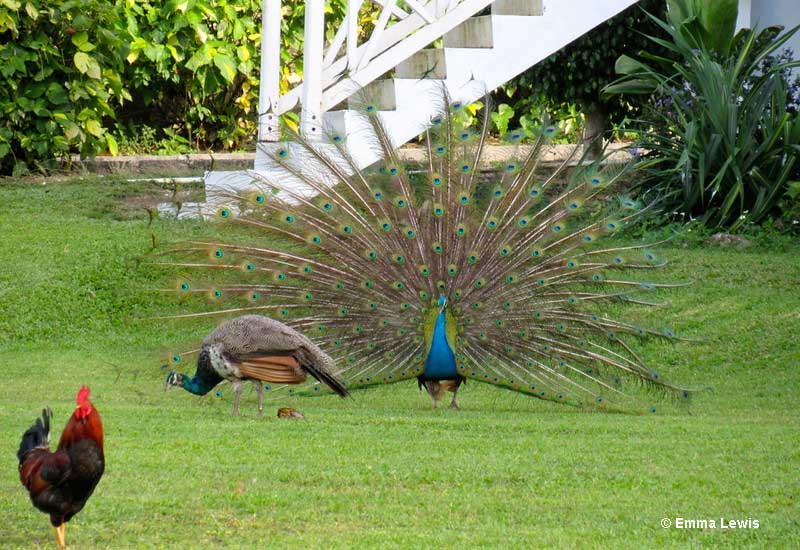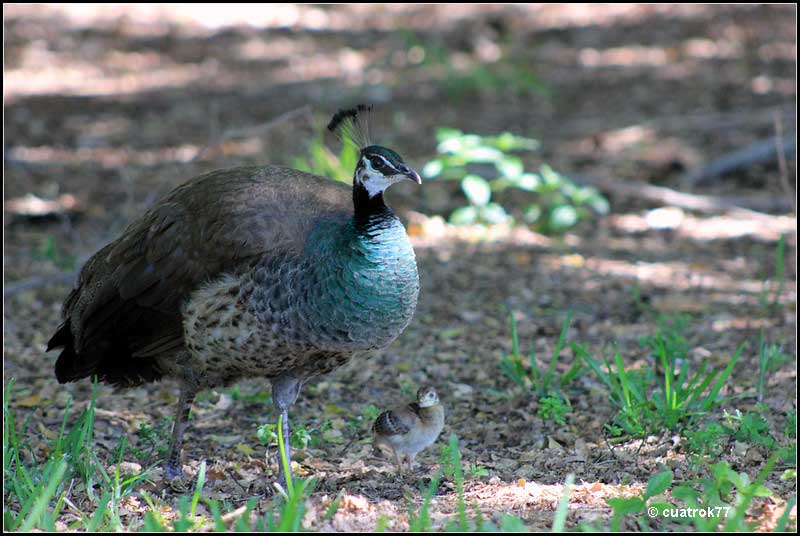
The baby peacock is often hidden from people’s view. When we think of peacocks, the first thing that comes to mind is their extravagant tail.
Peafowl are a type of wild fowl closely related to pheasants. They are known for their thrilling color display. However, the most famous anatomical feature is the huge peacock tail for courtship, with large iridescent feathers ending in an eye-like pattern.
Regardless, even these avian dandies start their lives as inconspicuous chicks called peachicks, raised solely by their mother – the peahen.
How do baby peacocks live out their early days? If you want to know more interesting facts about peachicks, read on!
On this page
Peacock Nesting
The Asian species of peafowl – the Indian (Blue) Peafowl (Pavo cristatus) and the Javanese (Green) Peafowl (Pavo muticus) are kept as decorative fowl and pet birds almost worldwide; however, their natural habitats are open forests and various human-inhabited areas of South and South-East Asia. Thus, their breeding season is dictated by the monsoons.
With the monsoon rains begin one of the most dazzling displays of the avian world. The peacock (male) bolsters his impressive tail that can be over 4 feet long and is often called ‘a train.’

He spreads and shakes the train in front of the peahen, also making various other flashy moves along the way. Studies show that females often pick males with larger tails and more “eyes.”
Related: Can Peacocks Fly?
Peacocks are ground nesters. The female builds a simple, primitive nest – a shallow depression in the soil lined with whatever vegetation is available. Then, she will lay 3 to 8 eggs on average, light green or tan in color. She will incubate them for around a month (28 – 30 days) with no help from the male.
Baby Peacocks – Peachicks
Peacocks are precocial, meaning the chicks are pretty well-developed upon hatching. The peahen raises them on her own, with no involvement from the male. Female peacocks are careful and watchful mothers, at least in the wild. Still, despite that, peachicks have very high mortality.
Estimates say that 2 out of 6 babies – only ~30% of the brood – make it to adulthood. Various predators like tigers, civets, leopards, jackals, and wild dogs hunt both adults and peachicks but have a higher success with vulnerable chicks.
Besides predation, baby peacocks are also susceptible to various diseases and parasites. Because of that, the mortality rate remains high (around 50%) even in captivity with few or no predators around.
Related: Baby Birds – From Hatching to Adulthood
Fortunately, the peachicks develop rather quickly. After a couple of weeks, they can fly into a tree in case of danger. After two months, their mother will slowly start letting them fend for themselves. Several months later, they will be stronger and more resilient.
What Does A Baby Peacock Look Like?
The peachicks look a lot less attractive than their parents (although, let’s admit it, they’re cute). Speaking from an evolutionary standpoint, this is quite sensible since attracting much attention as a vulnerable baby bird is a huge disadvantage.
Because of that, peachicks have a yellowish to light brown color, which helps them blend in with their surroundings. The body shape is similar to that of a pheasant or a chicken – with rounded heads, open eyes, rounded, stocky bodies, and quite long and strong legs.

Female peacock with a baby peacock.
After about four weeks, the juvenile peacock starts growing their trademark crests. Male chicks will also start growing tales. The peachicks look like the peahen in two months, only half the adult size.
The juvenile males take longer to get their adult coloration – although they begin to get their trademark colors at around 5 months, the shiny plumage will be complete only in their third year of life.
Related: How long do peacocks live?
By age 1, peahens develop fully and reach sexual maturity around the same time. On the other hand, peacocks mature more slowly, taking 3 full years to grow and shake those trains with pride. Peacocks are fully mature, and their tails are at peak development only at 5-6 years old!
How To Tell Baby Peacocks Apart?
Baby peacocks are very similar to baby pheasants. When hatchlings, they’re almost indistinguishable. However, as they gain more fluffy feathering, noticeable dark markings appear on pheasant chicks. In comparison, baby peacocks are lighter with less contrasting streaks.
What Do Baby Peacocks Eat?
Like adult peafowl, peachicks are omnivorous. First, they’ll absorb their yolk sack for 24-48 hours after hatching and don’t need to eat. After that, at only three to four days old, they can forage on their own while being watched closely by their mother.
On their family foraging excursions, the chicks will eat insects and small animals, grains, seeds, and berries suitable for their current size. Peachicks require a lot of protein to grow healthy.
The feeding of peachicks in captivity is trickier than with other fowl and requires some special steps to prevent food contamination that can lead to infections.
Related: What do peacocks symbolize?
Also, baby peafowl require a lot of drinking water as they dehydrate easily. The same goes for adults.
Baby Peacocks: Frequently Asked Questions
What does a baby peacock look like?
Peachicks have a yellowish-brown color, which helps them blend in with their surrounding. They have some darker brown streaks on their wings. In leucistic or all-white peafowl, the peachicks have a white-yellowish coloration. The body shape is similar to that of a pheasant or a chicken – rounded heads with open eyes, stocky bodies, and strong legs.
After about four weeks, the juvenile peafowl starts growing their trademark crests. The peachicks look like the peahen in two months, only half the adult size.
The peachicks’ less attractive appearance is an evolutionary advantage since it helps them blend in with their surroundings.
What is the correct name for a baby peacock?
The correct name for a baby peacock is peachick. People will understand you perfectly well if you say “peacock chick,” but this is still incorrect. Peacocks are male birds; the females are called ‘peahens,’ and their offspring are ‘peachicks.’
Although we’re all accustomed to calling them according to the showy male, the correct collective noun for this species, inclusive for all sexes and ages, is ‘Peafowl.’ Therefore, the correct alternative to ‘peachicks’ would be ‘Peafowl babies’ or ‘Peafowl chicks’ instead of ‘Peacock babies.’ The latter can only stand for the male chicks.
How long does it take for a peacock to grow its tail?
The peacock chicks need a lot of time to grow their majestic tails – in fact, they won’t be chicks anymore by the time the tail growth is complete. Three years is the average time for the tail to reach adult peacock proportions. However, the tail volume and size peak when the bird is 5 to 6 years old.
Can you tell the age of a peacock?
While it may not be possible to tell the exact birthday of a peacock, some physical traits can tell you about the developmental phase he’s currently in.
As hatchlings, peachicks look quite unsightly. The chicks with fluffy downy feathers are up to 1-2 months old. In their second month, the chicks gain most of the adult feathering but still lack the true color patterns. The juvenile peacocks start gaining coloration at five months of age, while their tails start growing as they turn 1. A peacock with an underdeveloped tail is probably between 1 and 2 years old.

Faustino
Thursday 18th of April 2024
I have one peahen that starts laying eggs, is ok to get the eggs at one nest because age lay eggs at 2 different locations ( inside the peahen coop)
Patrick O'Donnell
Monday 22nd of April 2024
@Faustino- Yes, just keep in mind that if you want to collect the eggs, it's best to get them shortly after the peahen lays them. Otherwise, she'll want to brood them.
Claire
Tuesday 5th of December 2023
We are going to buy Peafowl hens 8 months old. Are they old enough to tell there sex.
Katarina Samurovic
Monday 18th of December 2023
Hi Claire, Unless you want to do genetic testing, sexing peafowl is notoriously difficult - as this article puts it, more of an art than science. The first hints of sex in blue or green peafowl will likely start showing when a chick is just under 1 year old. As a general rule, the more colorful the bird, the more likely is that it's a male. Unfortunately, in white peafowl, sexing is an unreliable guessing game until the age of 2. Good luck!